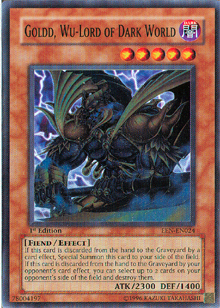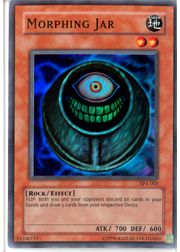Welcome to the first installment of this new column called Beating the Format. In this series, I plan to look at major events and play styles, and analyze a card, combo, or deck that raised interest at an event or caught our eye in a feature match. These cards, combos, and decks will be brought to you and broken down in a way that exposes exactly how they work in the current metagame and the ways they beat the format.
Shonen Jump Championship Durham has come and gone, and after the dust had settled, we were left with an unexpected Top 8 after many well-known players took unfortunate early losses. However, those who remained gave us a rather spectacular show—in particular, the tech of Goldd, Wu-Lord of Dark World, which I will cover here. I’ll also break down the unorthodox deck that swept the Swiss rounds—Zachary Austin’s Burn-to-Stein deck. To finish up, I’ll take a look at a combo which didn’t quite make the Top 8, but attracted the attention of a lot of top players. Creature Swap playing a major part in a Dark World deck? The more I think about it, the more its advantages become clear, and the more chances there are to exploit it!
First, we’re confronted by one of the most talked-about Shonen Jump Championship tech cards we’ve seen so far. On message boards, siding in random Goldd has become the thing of the moment. But what brought about this sudden increased use of an unsuspecting tribute monster? Ten weeks with no Shonen Jump Championship gave everybody the time needed to brood over certain possibilities as to what could counter the next metagame. To start, let’s take a look at Goldd itself:
 Goldd, Wu-Lord of Dark World
Goldd, Wu-Lord of Dark World
Attribute: Dark
Type: Fiend/Effect
Level: 5
2300 ATK/1400 DEF
If this card is discarded from the hand to the Graveyard by a card effect, Special Summon this card to your side of the field. If this card is discarded from the hand to the Graveyard by your opponent's card effect, you can select up to 2 cards on your opponent's side of the field and destroy them.
At first glance, Goldd isn’t a bad level 5 monster. It stands at 2300 ATK, so it runs over most commonly played cards in the format, including Cyber Dragon. It’s not quite enough to keep up with Mobius the Frost Monarch, Mobius’s brother Zaborg, or Jinzo, but a 2300 ATK will put up a nice fight. Being both Dark and a Fiend is always an advantage, especially if you’re a Chaos Sorcerer player or a fan of Dark Necrofear. However, Goldd’s effect really puts the icing on the cake. If it’s discarded from your hand by either player, then it’s coming to the field. But if it was your opponent’s card effect that did the discarding, you get to destroy up to two cards on the field. This is a potentially game-breaking effect, and can turn an easy 300 damage from a Spirit Reaper attack into a huge advantage that could swing the game’s momentum your way.
So, why play Goldd as a main or side deck card? In this format, some general trends include duelists selecting between one and three copies of Spirit Reaper and up to two copies of Don Zaloog. With all this hand control, the chance of hitting Goldd greatly increases. There’s also Morphing Jar to consider, and a well-timed Confiscation from your opponent could always hit that annoying Goldd. The effect will allow you to power through any potentially harmful traps or monsters and attack. Goldd’s 1400 DEF means it can evade Smashing Ground fairly easily, and don’t forget that if you’re in real trouble, you can always tribute summon it!
All in all, Goldd is a great anti-metagame card and will certainly see an increased amount of play, influenced by its recent success at Shonen Jump Durham. It also blends perfectly with the combo I’m going to look at next.
The Combo: Creature Swap Owning in a Dark World Deck?
 David Bustillos attracted the attention of a lot of top players at Shonen Jump Durham. His deck was, to quote Matt Peddle, “a Morphing Jar deck.” Effectively, it was a hybrid Dark World deck with many intricate combos. One of the main ideas was to use Creature Swap with Morphing Jar, then attack the Jar and have the second effect of Goldd or Sillva, Warlord of the Dark World hit. After all, the Jar would be under the opponent’s control.
David Bustillos attracted the attention of a lot of top players at Shonen Jump Durham. His deck was, to quote Matt Peddle, “a Morphing Jar deck.” Effectively, it was a hybrid Dark World deck with many intricate combos. One of the main ideas was to use Creature Swap with Morphing Jar, then attack the Jar and have the second effect of Goldd or Sillva, Warlord of the Dark World hit. After all, the Jar would be under the opponent’s control.
This clever sub-theme, along with the more imminent powers (such as Chaos Sorcerer) and other usual suspects (such as Cyber Dragon), provided Bustillos with many an opportunity to confuse his opponent and get the upper hand. Both cards work well in the deck on their own, too. Morphing Jar is a great card to have when the advantage might not be going your way, or if you want to get rid of your own Goldd. Creature Swap works well with Scapegoat, Sangan, or Mystic Tomato. However, together they create a nasty combo that can frustrate and overpower the opponent. (Just ask Matt Peddle.)
Dark World is a good counter to the current metagame on its own, but when it’s combined with all the normal tricks and a deck that’s playing Chaos Sorcerer or Pot of Avarice, it can become even more lethal, putting a stopper on many of your opponent’s hand disruption plans.
The Deck: Zachary Austin Does . . . Burn-to-Stein?
 If at first they’re not amazed, then try, try again. Cindie Uddstrom astounded attendees of the World Championship and her own National Championship, but only a limited number of people saw the deck she played. To this extent, her success didn’t do quite as much justice to the world of the Yu-Gi-Oh! TCG as it might have done if the deck were publicized online. It could have easily created one of the most net-decked concepts in the game. Zachary Austin used a main deck that was very similar to Uddstrom’s build, but it was his unique side deck play that set him apart from the competition. Let’s take a look at the deck that brought Austin a Top 8 finish at Shonen Jump Durham.
If at first they’re not amazed, then try, try again. Cindie Uddstrom astounded attendees of the World Championship and her own National Championship, but only a limited number of people saw the deck she played. To this extent, her success didn’t do quite as much justice to the world of the Yu-Gi-Oh! TCG as it might have done if the deck were publicized online. It could have easily created one of the most net-decked concepts in the game. Zachary Austin used a main deck that was very similar to Uddstrom’s build, but it was his unique side deck play that set him apart from the competition. Let’s take a look at the deck that brought Austin a Top 8 finish at Shonen Jump Durham.
For the main deck, Austin works off an Ojama Trio–style burn, using fewer burn monsters and more burn traps. Monster-wise, the burn cards are Stealth Bird, Lava Golem, Des Koala, and Cannon Soldier. Naturally, the deck plays three copies of Wave-Motion Cannon and its trap lineup is also burn-heavy. With Torrential Tribute the only card not helping with potential burn, Austin’s trap setup is risky—but if it works, it works extremely well. To stall his opponent, he plays a pair of Level Limit – Area B, but no Gravity Binds. This is because the deck is already trap-heavy, and there’s enough stall from the monsters and spells to last until Austin can burn out his opponent. The remainder of Austin’s monsters will support either his burn or Cyber-Stein theme, which makes side decking a lot easier.
This deck is an extremely effective counter to the immediate metagame, as it stands. Burn is useful in a slow-tempo environment, taking advantage of the Merchant-Pot-Turbo deck with its quick burn cards and field-locking Ojama tokens. The chainable trap cards make life a lot easier for the multiple copies of Mobius that are floating around. Secret Barrel uses the idea of mass-advantage against the opponent, as it punishes him or her with 200 damage for every card that he or she has. It might not seem like much, but little bits of damage eventually stack up. With a bit of encouragement from Wave-Motion Cannon and Stealth Bird, this can lead to a pretty quick win.
Cyber-Stein counters the current metagame quite effectively, because with the attitude of “sit and wait behind my Spirit Reaper,” and the lack of chainable trap play, there isn’t much to do other than sit back and hope your opponent isn’t holding that Megamorph or Limiter Removal.
Combining these two ideas makes for a lethal twist of wits and surprise. Will this suspenseful idea become one of the more popular choices in the future? Only time will tell, and with Shonen Jump Championship Orlando only days away, we don’t have too long to wait! Stay tuned to Metagame.com for all the action and to see how these new format-beating ideas will affect us. Who will take advantage of them and become Shonen Jump Orlando Champion?
James Pennicott
AveragePsycho (at) gmail (dot) com